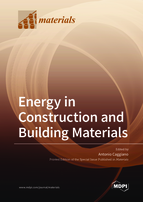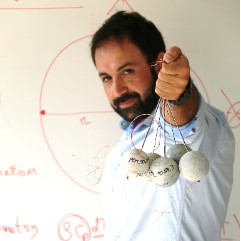Energy in Construction and Building Materials
A special issue of Materials (ISSN 1996-1944). This special issue belongs to the section "Construction and Building Materials".
Deadline for manuscript submissions: closed (30 September 2021) | Viewed by 53637
Special Issue Editor
Interests: sustainability in construction and building materials; recycling; smart materials; smart buildings; energy-saving; green buildings; eco-friendly materials; nearly zero-energy buildings; energy efficiency; energy storage; phase change materials; renewable energy resources; zero CO2 emissions; CO2 storage in materials; modeling; multiscale; multiphysics; micro- and meso-scale
Special Issues, Collections and Topics in MDPI journals
Special Issue Information
Dear Colleagues,
Improving energy efficiency with construction and building materials represents one of the key challenges in the recent research and developments of the international community. Innovations in the construction sector are seeking breakthrough answers by using smart and intelligent materials, energy saving concepts, and cost-effective solutions, in order to ultimately reach technologies with zero CO2 emissions.
Therefore, the aim of this Special Issue is to explore the current state of the art, new ideas, and novel developments on the relevant topics that link energy efficiency to construction and building materials. A wide range of research outputs on various topics, which are contributing to an enhanced energy efficiency and a sustainable materials use for residential and non-residential buildings, is expected.
The emphasis of this Special Issue will be on collecting fundamental studies, experimental research, numerical approaches, analysis tools, design guidelines, and so on, for energy efficient materials and construction. It is the ambition of this Issue to hugely stimulate and spread the latest knowledge on energy and construction and building materials. It will be a basis for new ideas on the various topics for young investigators as well as leading experts in the field of Materials Science and Engineering.
Dr. Antonio Caggiano
Guest Editor
Manuscript Submission Information
Manuscripts should be submitted online at www.mdpi.com by registering and logging in to this website. Once you are registered, click here to go to the submission form. Manuscripts can be submitted until the deadline. All submissions that pass pre-check are peer-reviewed. Accepted papers will be published continuously in the journal (as soon as accepted) and will be listed together on the special issue website. Research articles, review articles as well as short communications are invited. For planned papers, a title and short abstract (about 100 words) can be sent to the Editorial Office for announcement on this website.
Submitted manuscripts should not have been published previously, nor be under consideration for publication elsewhere (except conference proceedings papers). All manuscripts are thoroughly refereed through a single-blind peer-review process. A guide for authors and other relevant information for submission of manuscripts is available on the Instructions for Authors page. Materials is an international peer-reviewed open access semimonthly journal published by MDPI.
Please visit the Instructions for Authors page before submitting a manuscript. The Article Processing Charge (APC) for publication in this open access journal is 2600 CHF (Swiss Francs). Submitted papers should be well formatted and use good English. Authors may use MDPI's English editing service prior to publication or during author revisions.
Keywords
- Energy saving with materials
- Energy efficiency
- Energy harvesting
- Energy storage
- Energy sustainability
- Energy transformations
- Health and thermal comfort
- Heating and cooling
- Heat recovery systems
- Building physics for materials
- Insulation passive and active systems
- Intelligent energy saving materials
- Multi-scale and multi-physics modelling
- Piezoelectric materials
- Phase change materials
- Renewable energy resources
- Smart materials
- Thermal energy storages
- Zero CO2 emissions
- CO2 storage in materials.







